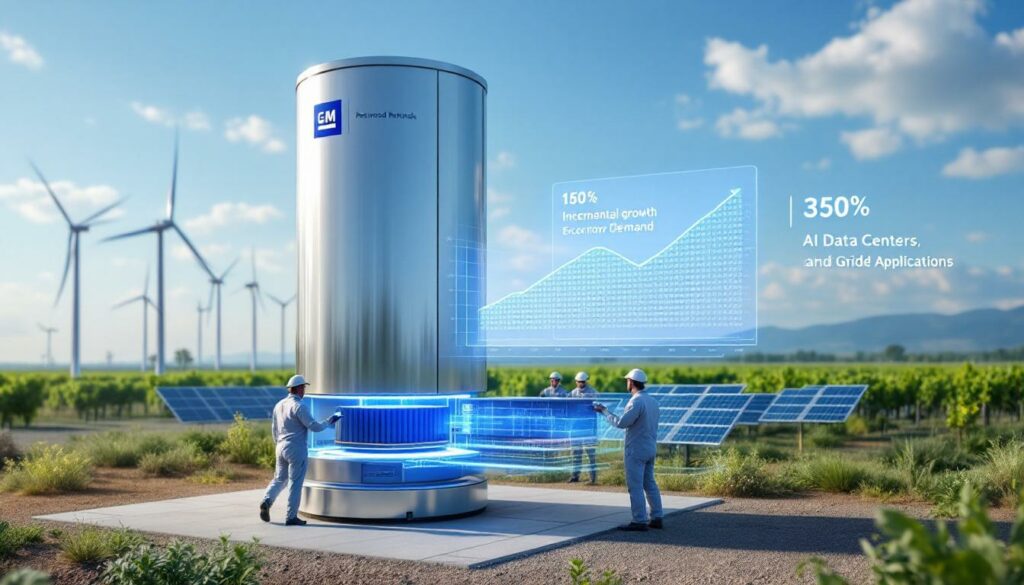How GM and Redwood Materials Are Revolutionizing Battery Recycling for Energy Storage
In a significant move toward sustainable energy solutions, General Motors and Redwood Materials announced a groundbreaking partnership in July 2025 aimed at transforming how GM and Redwood Materials recycled battery energy storage systems are developed and deployed. This collaboration represents a pivotal shift in how the industry approaches battery lifecycle management, with far-reaching implications for both environmental sustainability and energy resilience.
The Groundbreaking Partnership Reshaping Energy Storage
What Does This New Collaboration Entail?
The non-binding Memorandum of Understanding (MoU) signed on July 16, 2025, establishes an innovative framework for creating energy storage systems (ESS) that combine both new US-manufactured batteries and second-life electric vehicle battery packs. This agreement builds upon a previous collaboration announced in May 2025, which focused on recycling manufacturing scrap from GM's battery facilities.
"Electricity demand is climbing, and it's only going to accelerate. To meet that challenge, the US needs energy storage solutions that can be deployed quickly, economically, and made right here at home," explained Kurt Kelty, GM's Vice President of Batteries, Propulsion and Sustainability. "GM batteries can play an integral role. We're not just making better cars – we're shaping the future of energy resilience."
The partnership leverages GM's manufacturing infrastructure, including the Ultium Cells facility in Warren, Ohio (a joint venture with LG Energy Solution that began production in August 2022) and the battery assembly operations in Spring Hill, Tennessee. Meanwhile, Redwood Materials brings specialized expertise in battery recycling breakthrough and system integration through its Redwood Energy division, launched in June 2025.
Why Is This Partnership Transformative for Energy Infrastructure?
This collaboration addresses multiple critical challenges facing the energy sector simultaneously. By creating domestically sourced and manufactured energy storage solutions, the partnership strengthens America's energy independence while providing rapid-deployment power solutions.
JB Straubel, founder and CEO of Redwood Materials, highlighted the urgency driving this initiative: "Electricity demand is accelerating at an unprecedented pace, driven by artificial intelligence and the rapid electrification of everything from transportation to industry. Both GM's second-life EV batteries and new batteries can be deployed in Redwood's energy storage systems, delivering fast, flexible power solutions and strengthening America's energy and manufacturing independence."
The partnership's focus on creating "domestic solutions from cell to system" positions it as a potential model for addressing both energy security and environmental sustainability concerns simultaneously.
The Surging Demand for Advanced Energy Storage Solutions
What Factors Are Driving Energy Storage Growth?
Several converging factors are creating unprecedented demand for energy storage capacity. Artificial intelligence computing facilities require massive power infrastructure, with data centers becoming one of the most electricity-intensive industrial applications. This comes alongside the widespread electrification of transportation and industrial processes, placing extraordinary demands on existing grid infrastructure.
Additionally, the increasing adoption of renewable energy sources necessitates sophisticated energy transition strategy solutions to address intermittency challenges and ensure grid stability. Critical infrastructure resilience needs are also becoming more prominent as climate change impacts and energy security concerns grow.
Current Market Position and Future Projections
According to 2025 EIA data cited by Fastmarkets, battery storage represented just 2% of the 1,230 GW of utility-scale electricity generating capacity in the United States as of 2024. However, the sector is poised for explosive growth, with plans to add 19.6 GW of utility-scale battery storage in 2025 alone.
This remarkable expansion is continuing despite evolving federal incentive structures, including changes to the 30D credit and 45X credit time limits under the One Big Beautiful Bill (OBBB). Industry analysts note that while these policy shifts may affect EV demand, the growth in energy storage demand remains robust, driven primarily by AI data center requirements and grid modernization needs.
The significant gap between existing storage capacity and projected energy demands creates a substantial market opportunity for innovative solutions like the GM-Redwood Materials partnership.
Technical Implementation of Recycled Battery Storage Systems
How Will the Integration Process Work?
The Redwood Energy division specializes in integrating both new battery modules and repurposed EV battery packs into comprehensive energy storage systems. Through this partnership, Redwood will pair its integration expertise with second-life GM electric vehicle battery packs along with new US-built batteries.
This dual-source approach represents a significant engineering achievement, requiring sophisticated systems to standardize performance across batteries with different histories, chemistries, and degradation profiles. While specific technical details remain proprietary, the system is designed to deliver reliable, grid-scale energy storage that meets utility and commercial performance standards.
Manufacturing and Supply Chain Framework
The partnership's manufacturing framework leverages GM's established battery production infrastructure. The Ultium Cells facility in Warren, Ohio (joint venture with LG Energy Solution) provides new battery modules, while the integration with Spring Hill, Tennessee battery assembly operations enables a streamlined supply chain.
This domestic sourcing strategy provides multiple advantages, including reduced transportation emissions, improved supply chain resilience, and decreased dependence on imported materials. By creating an efficient recycling-to-deployment pathway, the partnership aims to maximize both economic and environmental benefits.
Environmental and Economic Benefits of Battery Recycling
What Are the Sustainability Advantages?
GM and Redwood Materials recycled battery energy storage systems offer significant environmental benefits compared to conventional approaches. By extending the utility of EV batteries beyond their automotive service life, the partnership reduces the overall environmental footprint of both electric vehicles and energy storage solutions.
This approach substantially reduces pressure on raw material extraction and processing, particularly for critical minerals like lithium, cobalt, and nickel. The lower carbon footprint results from avoiding the energy-intensive processes required for new battery material production and processing.
Perhaps most importantly, this initiative advances circular economy principles within the battery value chain, establishing pathways for materials to remain in productive use rather than entering waste streams.
Economic Impact and Market Advantages
The economic benefits of recycled battery energy storage extend beyond environmental considerations. The approach creates significant cost efficiencies by repurposing high-value battery resources that have already been manufactured but no longer meet the rigorous performance standards of automotive applications.
This strategy decreases reliance on imported battery materials and components, strengthening domestic supply chains. The localized manufacturing and advanced battery recycling facility operations also create job opportunities in high-tech manufacturing sectors across multiple states.
From a competitive standpoint, this innovative approach positions both GM and Redwood Materials advantageously within the rapidly expanding energy storage market, potentially establishing new industry standards for battery reuse and recycling.
Industry Context and Market Trends
How Does This Fit Within the Broader Energy Transition?
The GM-Redwood Materials partnership emerges against a backdrop of evolving energy policies, including the One Big Beautiful Bill (OBBB) with its implications for EV tax credits (30D repeal) and production tax credits (45X time limits). Despite these policy shifts, energy storage demand continues to surge, highlighting the fundamental market drivers beyond incentive structures.
This collaboration represents a strategic positioning within the expanding US battery manufacturing ecosystem, potentially establishing templates for other automotive manufacturers looking to extend battery value chains beyond vehicle applications.
When compared with international battery metals investment initiatives, the GM-Redwood approach demonstrates how private sector partnerships can advance sustainable practices even as regulatory frameworks continue to evolve.
What Challenges and Opportunities Lie Ahead?
Several technical challenges must be addressed as this partnership scales. Standardizing diverse battery pack architectures presents engineering complexities, while managing performance variability between new and second-life battery systems requires sophisticated control systems.
Scaling recycling operations to meet accelerating market demand will require significant investment in processing capacity and logistics. Additionally, the partnership must navigate evolving regulatory frameworks for battery reuse and recycling across multiple jurisdictions.
Despite these challenges, the partnership presents substantial opportunities. The growing availability of end-of-life EV batteries creates a steadily expanding resource stream, while increasing energy storage demand ensures strong market pull for innovative solutions.
Future Implications for the Energy Storage Landscape
Expansion Potential and Innovation Pathways
The GM-Redwood Materials collaboration model offers significant scalability as the volume of available second-life batteries increases. This approach creates natural expansion pathways as the electric vehicle market grows and battery returns accelerate.
Technology transfer opportunities extend to adjacent applications and markets, including commercial building energy management, microgrid development, and green energy design integration. The partnership's expertise in battery assessment, refurbishment, and integration has potential applications across the broader energy ecosystem.
The flexible framework established by the partnership also allows for integration with next-generation battery chemistries as they emerge, ensuring adaptability to technological advancement.
How This Could Transform Energy Storage Implementation
This partnership establishes new industry benchmarks for battery recycling and reuse that could influence broader market practices. By demonstrating the commercial viability of second-life applications for EV batteries, the initiative creates replicable models for other automotive and battery manufacturers.
The collaboration accelerates development of domestic battery supply chains, reducing import dependencies and creating more resilient energy infrastructure. Perhaps most significantly, it pioneers innovative business models for maximizing the value of EV batteries throughout their entire lifecycle.
This approach fundamentally transforms how we conceptualize battery assets—not as components with a single useful life, but as material systems that can serve multiple purposes across decades of deployment.
Comparative Analysis: Battery Storage Solutions in Today's Market
| Solution Type | Key Advantages | Implementation Challenges | Optimal Applications |
|---|---|---|---|
| New Battery ESS | Consistent performance specs, Extended lifespan, Full warranty coverage | Higher material costs, Greater environmental footprint, Supply chain dependencies | Mission-critical infrastructure, Long-duration storage needs, Premium applications |
| Second-Life EV Batteries | Reduced acquisition cost, Lower environmental impact, Extended useful life | Performance variability, Additional testing requirements, Limited warranty options | Peak demand management, Backup power systems, Ancillary grid services |
| Hybrid (New + Recycled) | Optimized cost structure, Balanced performance profile, Supply chain resilience | Complex system integration, Performance matching requirements, Specialized management systems | Commercial and industrial applications, Utility-scale projects, Campus microgrids |
| Conventional Energy Storage | Well-established technology, Widespread deployment experience, Known performance parameters | Physical limitations, Environmental considerations, Limited innovation potential | Traditional grid applications, Established use cases, Conventional backup systems |
FAQ: Understanding the GM-Redwood Materials Partnership
What makes this collaboration particularly significant for the energy sector?
This partnership represents a unique convergence of automotive and energy storage expertise, combining GM's manufacturing scale with Redwood's specialized recycling capabilities. By creating comprehensive domestic solutions for the rapidly growing energy storage market, the collaboration addresses both environmental and energy security priorities simultaneously.
The establishment of viable commercial pathways for second-life applications of EV batteries creates value streams that weren't previously accessible at scale, potentially transforming the economics of both electric vehicles and energy storage.
How does battery recycling improve energy storage economics?
Recycled battery energy storage systems offer several economic advantages. By efficiently reusing existing battery components, material costs are substantially reduced compared to new battery systems. This translates to lower total ownership costs for grid-scale and commercial energy storage deployments.
The approach creates value from assets that would otherwise become waste streams, improving overall resource efficiency. Additionally, the diversified sourcing strategy helps insulate supply chains from material price volatility and shortages that have affected battery markets in recent years.
What deployment timeline can be expected for these recycled battery systems?
Following the July 2025 partnership announcement, initial implementation phases will focus on pilot deployments to validate performance and refine integration processes. Scaled deployment will then proceed based on second-life battery availability from the growing EV market.
The partners intend to integrate these systems with existing and planned energy infrastructure projects, with long-term expansion accelerating as electric vehicle battery returns increase in volume over the coming decades.
How do recycled batteries compare to new batteries in performance metrics?
Performance characteristics vary based on battery age, chemistry, and usage history. However, the GM-Redwood partnership employs sophisticated engineering solutions for standardizing output across varied battery sources to ensure consistent performance.
System design considerations include optimizing the balance between new and recycled components to achieve target performance specifications. Advanced monitoring and management systems provide real-time performance data to ensure reliability across the battery system's operational life.
While second-life batteries typically show some capacity degradation compared to new units, they remain well-suited for stationary storage applications where energy density requirements are less stringent than in automotive uses.
Further Exploration:
Readers interested in learning more about innovations in recycled battery energy storage systems can also explore related educational content from Fastmarkets, which offers industry insights on battery raw materials markets and sustainable energy technologies.
Ready to Catch the Next Major Mineral Discovery?
Stay ahead of the market with Discovery Alert's proprietary Discovery IQ model, which instantly notifies investors of significant ASX mineral discoveries and transforms complex data into actionable insights. Explore historic discoveries that generated substantial returns by visiting Discovery Alert's dedicated discoveries page and begin your 30-day free trial today.




